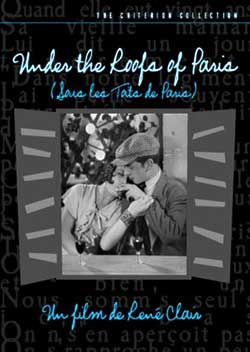 For over half a century, film lovers have remembered René Clair’s Under the Roofs of Paris (Sous les toits de Paris) for its marvelous opening sequence: Shots that begin with the rooftops of a working class Parisian neighborhood, then descend from that cheerful land of chimneypots down to a little square via some elegant crane work.
For over half a century, film lovers have remembered René Clair’s Under the Roofs of Paris (Sous les toits de Paris) for its marvelous opening sequence: Shots that begin with the rooftops of a working class Parisian neighborhood, then descend from that cheerful land of chimneypots down to a little square via some elegant crane work.
In the square, Clair’s camera discovers – and the spontaneity of discovery is driving the action – a singer and sheet-music seller, leading the crowd in song as he hawks as many of his penny wares as he can. As he does, and without breaking rhythm, he and the camera spy a beautiful young woman in danger of having her pocketbook picked. He simultaneously tries to save her cash and, who knows, maybe get to know her a little bit better. While this goes on, Clair insures neither the music nor his camera flag, and both rise to high points signaled not with a crane shot mind you – no, Clair’s done that – but with an elevator shot. This is a straight-up movement that requires the construction of a special scaffolding and Clair uses it to photograph the inhabitants of an apartment building, from ground floor to top, as they lean out and listen to the music from below.
Having gone to the trouble of so much construction, you don’t want to begrudge the director a second use of it a few minutes later. He was only 31, after all, and he was helping to push open the door to the sound era; the sense of exhilaration must have been overwhelming. But his film, while still charming, is not the major work it was clearly designed to be. The new Criterion Collection release of Under the Roofs of Paris contains enough material to enjoy the movie to its fullest as well as to see what pulled Clair up short.
Aside from the excellent digital transfer, the most notable aspect of Criterion’s package is what we haven’t seen for a half century: The movie’s original opening, which Clair removed from the film for a 1950 re-release. That opening is romantically atmospheric in its own right, featuring rain-slicked sidewalks, passing feet, and crashing umbrellas, but it’s much more dramatically angled than the street-singer sequence that, at the time, followed it. We find out at the top (instead of much later) that the pretty blond girl who wanders into the square and almost gets her money stolen is Pola (Pola Illery), the girlfriend of the gangster Louis (Edmond Gréville). So, rather than wandering into a casually innocent conversation and possible flirtation with the street singer Albert (Albert Préjean), as it appears to us now, Pola was engaging in possibly more dangerous behavior.
But however much it may have changed just the opening, it’s more than likely that Clair was out to change the tone of the entire movie. Under the Roofs is full of musical effects that either substitute for or complement the occasional use of recorded dialogue, including specially scored phrases played to match the emotional timbre of conversations. But Clair is not a particularly musical director; his scenes don’t have any more than a routine rhythmic quality (for 1930 that is; if he appeared on the scene in today’s tuneless era he’d be a veritable cinematic Mozart). And his characters don’t handle themselves musically. Even when they’re singing, it’s a job, not an elemental expression. This lack of musicality reaches its most peculiar point in a scene in a working class dance hall where most of the tensions among the film’s romantic factions is worked out off the dance floor.
Making a movie about singers, gangsters, and flirts with partial "live" sound and a pre-recorded musical score can hamstring a director more than it frees him. He can’t revert to the pantomime of silent film, nor can he jump ahead to the complete talking and singing of fully-realized sound. Somehow, and especially if he’s going to plunge to the murky depths of melodrama, he’s needs to invoke some combination of rhythm and melody. If he can’t, he’s going to have to pull back from being expressive and settle for being ornamental.
This seems to have been what Clair did with Under the Roofs, perhaps when he made it, and certainly in 1950, when he seems to have judged it. Further evidence comes in 1966 interview Clair gave to the BBC, in which the director, now 65, insists that a film director’s job is only to decorate the screen. This is a bitterly ironic statement even for a member of the French Academy, though it seems to have passed by the placid interviewer without much fuss.
With that recutting, with that statement, Clair seemed to be denying that he had ever even had any ambition in the first place. This leads us to paradox since even when he was recutting Under the Roofs, Clair was overseeing the collection of early articles on cinema into book form.
Whatever Clair was up to, it’s undeniable that the result of all his juggling was to brighten up a potentially troubling love story at the expense of any potential emotional complexity. This doesn’t seem to be because Clair distrusted the existence of such complexity or doubted tha film could deal with it. It was just that somehow, he couldn’t say it with music.
